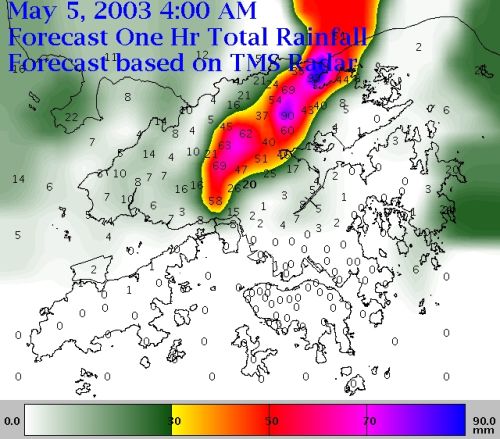Rainstorm nowcasting system planned for Pearl River Delta
Rainstorm nowcasting system planned for Pearl River Delta (25 September 2003)
|
A 4-member delegation from the Guangdong Meteorological Bureau led by Deputy Director of Guangdong Meteorological Observatory, Mr. Zhuang Xudong, visited the Hong Kong Observatory between 22 and 25 September 2003. The two sides exchanged technology and experience on rainstorm nowcasting (that is, forecasts up to a few hours ahead). The two sides also discussed cooperation plans on the development of a rainstorm nowcasting system covering the whole Pearl River Delta by integrating the computer software developed by the Hong Kong Observatory with the automatic weather station network jointly developed by Guangdong, Hong Kong and Macao. The common goal is to enhance the capability of weather services in the region to monitor and forecast rainstorms. Severe rainstorms affect southern China every year. It is of utmost importance to mitigate the casualties and economic losses brought by these rainstorms. The Hong Kong Observatory has recently developed a rainstorm nowcasting system called SWIRLS (Short-range Warning of Intense Rainstorms in Localized Systems) to forecast rainfall in the territory up to 3 hours ahead. This system calculates the movement of rain areas detected by weather radars and then projects from these movements the rainfall in the territory. The radar data is constantly calibrated against rainfall measured by over 100 automatic rain gauges in Hong Kong so that the rainfall forecasts generated are as accurate as possible. The system takes account of the special characteristics of Hong Kong and is one of the most advanced rainstorm nowcasting systems in the world. SWIRLS was put into operation in early 1999. It has been providing very useful guidance to forecasters on very-short-range rainfall forecasts for the issuance of the Rainstorm and Landslip Warnings since (see illustration in Figure 1). The weather services in Guangdong, Hong Kong and Macao have been expanding and upgrading their weather observing networks in recent years. Currently, the observing systems in the Pearl River Delta area comprise of 6 weather radars and more than 500 automatic weather stations in Guangdong (Figure 2); 3 weather radars, 4 wind profilers, one LIDAR (Light Detection and Ranging System), over 70 automatic weather stations and 100 automatic rain gauges in Hong Kong; as well as one weather radar and 10 automatic weather stations in Macao. Together these systems now represent one of the densest and most advanced weather observing networks in the world. Weather knows no geographical boundaries. Rainstorms which develop in the vicinity of the Pearl River Delta may equally affect Guangdong, Macao and Hong Kong. The weather services in the three places have been holding annual scientific exchange meetings and various collaborative projects for the past decade. The setting up of automatic weather stations on offshore islands off the Pearl River Delta jointly by the three parties is a good example of such cooperation. The possibility of expanding SWIRLS to cover the entire Pearl River Delta area was discussed by the three parties during the annual cooperation meeting early this year. This expanded SWIRLS would provide the scientific basis for rainstorm forecasting in the Pearl River Delta region. The visit by experts of Guangdong Meteorological Bureau, which has just ended, was the first step in taking forward the cooperative project. Mr. Lam Chiu Ying, Director of the Hong Kong Observatory, pointed out, "The Observatory has been working closely with the Guangdong Meteorological Bureau and the Macao Meteorological and Geophysical Bureau for many years. An expanded SWIRLS built through the joint effort of the three parties will strengthen the Pearl River Delta's capability as a whole to defend itself against the assault of severe rainstorms, reduce casualties and minimize economic losses, as well as contribute to further development of the region".
>Figure 1: Sample output of the Hong Kong Observatory's SWIRLS rainstorm nowcasting system in a Red rainstorm situation (unit: mm).
Figure 2: Distribution of automatic weather stations (red dots) and weather radars (black icons) in Guangdong. The weather radars in Hong Kong and Macao are also shown.
Figure 3: Delegates from Guangdong Meteorological Bureau experimenting with the SWIRLS rainstorm nowcasting system at the Open Laboratory of the Hong Kong Observatory. |


